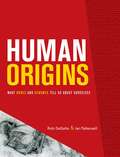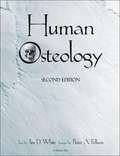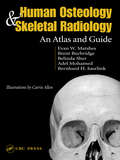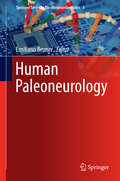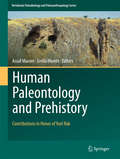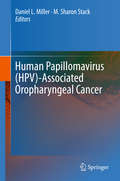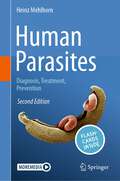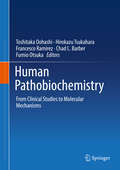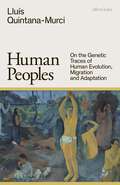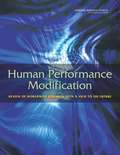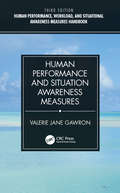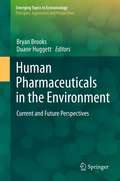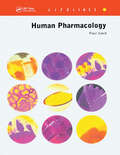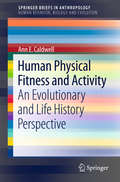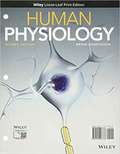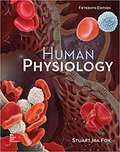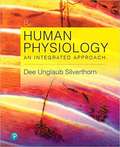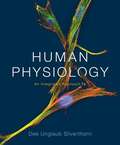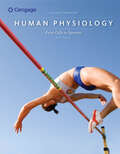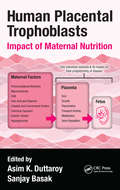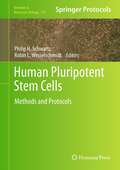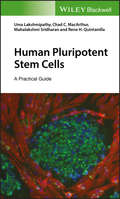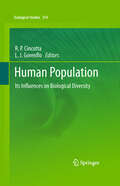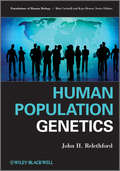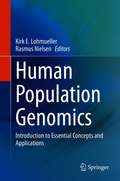- Table View
- List View
Human Origins: What Bones and Genomes Tell Us About Ourselves
by Rob Desalle Ian TattersallEver since the recognition of the Neanderthals as an archaic form of human in the mid-nineteenth century, the fossilized bones of extinct humans have been used by paleoanthropologists to explore human origins. These bones tell the story of how the earliest humans first emerged in Africa some 6 to 7 million years ago. The bones also reveal that as humans became anatomically and behaviorally more modern, they swept out of Africa in waves into Asia, Europe, and finally into the New World. Even as paleoanthropologists continued to make important discoveries, experts in genetics were looking at the human species from a very different angle. In 1953 James Watson and Francis Crick first envisioned the double helix structure of DNA, the basic building block of all life. In the 1970s it was shown that humans share 98.7 percent of their genes with the great apes--that in fact genetically we are more closely related to chimpanzees than chimpanzees are to gorillas. And most recently the entire human genome has been mapped--we now know where each of the genes are located on the DNA strands that make up our chromosomes. In Human Origins: What Bones and Genomes Tell Us about Ourselves, two of the worlds foremost scientists, geneticist Rob DeSalle and paleoanthropologist Ian Tattersall, show how research into the human genome confirms what fossil bones have told us about human origins. This unprecedented integration of the fossil and genomic records provides the most complete understanding possible of humanity's place in nature, its emergence from the rest of the living world, and the evolutionary processes that have molded human populations to be what they are today.
Human Osteology
by Tim D. WhiteHuman Osteology, Second Edition is designed for students and professionals who wish to advance their osteological skills in terms of accurately identifying human skeletal remains, however isolated and fragmentary. These remains can then be used to deduce information about the original lives of the deceased individuals. This book is an essential text for courses on the human skeleton, as well as a basic reference and field manual for professional osteologists and anatomists, forensic scientists, paleontologists, and archaeologists. Human Osteology, Second Edition includes nearly a decade of advances in osteological research since the first edition. Each chapter has been strengthened and updated, including a new chapter on molecular osteology and four new case studies drawn from more recent research. This edition also includes a valuable guide to electronic resources in osteology.
Human Osteology and Skeletal Radiology: An Atlas and Guide
by Evan W. Matshes Bernard JuurlinkHuman Osteology and Skeletal Radiology: An Atlas and Guide features nearly 700 photographs, line drawings, and radiographs demonstrating individual bones and collections of bones from a wide variety of detailed perspectives to aid in rapid identification of bone material. Intended as a handbook for those investigating skeletal remains, this atlas covers general and specific anatomic terms, includes comparative images of bones in photographic and radiographic form, and notes important comparisons among adult, juvenile, and fetal bones. It also provides a resource for those involved in gross anatomy and skeletal specimen laboratory study.
Human Paleoneurology
by Emiliano BrunerThe book presents an integrative review of paleoneurology, the study of endocranial morphology in fossil species. The main focus is on showing how computed methods can be used to support advances in evolutionary neuroanatomy, paleoanthropology and archaeology and how they have contributed to creating a completely new perspective in cognitive neuroscience. Moreover, thanks to its multidisciplinary approach, the book addresses students and researchers approaching human paleoneurology from different angles and for different purposes, such as biologists, physicians, anthropologists, archaeologists and computer scientists. The individual chapters, written by international experts, represent authoritative reviews of the most important topics in the field. All the concepts are presented in an easy-to-understand style, making them accessible to university students, newcomers and also to anyone interested in understanding how methods like biomedical imaging, digital anatomy and computed and multivariate morphometrics can be used for analyzing ontogenetic and phylogenetic changes according to the principles of functional morphology, morphological integration and modularity.
Human Paleontology and Prehistory
by Assaf Marom Erella HoversThe aim of the book is to present original and though-provoking essays in human paleontology and prehistory, which are at the forefront of human evolutionary research, in honor of Professor Yoel Rak (a leading scholar in paleoanthropology). The volume presents a collection of original papers contributed by many of Yoel's friends and colleagues from all over the globe. Contributions from experts around the globe fall roughly into three broad categories: Reflections on some of the broad theoretical questions of evolution, and especially about human evolution; the early hominins, with special emphasis on Australopithecus afarensis and Paranthropus; and the Neanderthals, that contentious group of our closest extinct relatives. Within and across these categories, nearly every paper addresses combinations of methodological, analytical and theoretical questions that are pertinent to the whole human evolutionary time span. This book will appeal most to scholars and advanced students in paleoanthropology, human paleontology and prehistoric archaeology.
Human Papillomavirus (HPV)-Associated Oropharyngeal Cancer
by M. Sharon Stack Daniel L. MillerHead and neck squamous cell carcinoma (HNSCC), the sixth most prevalent cancer worldwide, remains a very difficult disease to treat and cure despite intensive investigation into molecular etiologies and tumor progression pathways. Due to public health efforts encouraging smoking cessation, the overall incidence of HNSCC has decreased in recent years in many countries. In contrast, the incidence of oropharyngeal squamous cell carcinoma (OPSCC) has increased significantly, and this subtype of HNSCC is commonly associated with human papillomavirus (HPV) infection. Moreover, individuals with HPV-positive OPSCC are generally younger and are frequently non-smokers, suggesting that HPV-associated OPSCC represents a distinct biologic entity. This volume summarizes the spectrum of current HPV-associated OPSCC research from the fundamental basic science to translational surgery and treatment approaches. Chapters are contributed by authoritative leaders in the fields of research and clinical care. Initial chapters address epidemiology, behavioral correlates of HPV infection, and racial disparities in oropharyngeal cancer. This is followed by chapters detailing HPV virology with focus on viral transformation, viral replication, and host response to viral infection. The molecular biology of HPV-associated OPSCC is investigated in chapters detailing alterations in signaling networks and unique mutational profiles of human tumors. Clinical presentation, surgical perspectives, and treatment paradigms specific to HPV-associated OPSCC conclude the volume. This comprehensive volume provides an up-to-date overview of both scientific discovery and clinical management of this emerging public health problem.
Human Parasites: Diagnosis, Treatment, Prevention
by Heinz MehlhornThe new edition of this textbook provides an up-to-date overview of the most important parasites in humans and their potential vectors. Climate change and globalization steadily favor the opportunities for parasites to thrive. These challenges call for the latest information on pathogen transmission routes and timely preventive measures.For each parasite, this book offers a concise summary in eleven sections:1. Naming2. Geographic distribution and epidemiology3. Morphology, biology and life cycle4. Disease symptoms5. Diagnosis6. Infection pathways7. Prophylaxis8. Incubation period9. Prepatency10. Patency11. Therapeutic optionsNumerous tables, diagrams and over 200 colorful illustrations highlight the main aspects of parasitic infestations and present suitable control measures. Moreover, 60 questions help to test readers’ theoretical knowledge of the field. Readers can additionally download the free Springer Nature Flashcards App and benefit from the digital study questions.In short, this work is highly recommended for anyone looking to delve into the field of human parasitology. It is intended for students of biology and human medicine, medical doctors, pharmacists and laboratory staff alike. Furthermore, persons who plan to visit or live longer in endemic regions will find essential information on necessary preventive and control measurements.
Human Pathobiochemistry: From Clinical Studies to Molecular Mechanisms
by Hirokazu Tsukahara Toshitaka Oohashi Francesco Ramirez Chad L. Barber Fumio OtsukaThis textbook uses a case-study approach to present the core principles of biochemistry and molecular biology in the context of human disease to students who will be involved in patient care. The 29 clinical cases have been carefully selected to cover key scientific concepts and some common, and other not so common, diseases. While the principal focus is on topics relating to metabolic disease, further subjects such as connective tissue disorders, neurological disorders, auto-inflammatory disorders, infective diseases, and cancer are also addressed. Each chapter provides a specific patient report that includes the natural history, pertinent clinical laboratory data, physical findings, subsequent diagnosis, and therapy. This is followed by a comprehensive discussion of the normal biochemical processes and reactions pertaining to the case, along with the pathophysiological mechanisms of the disease. Graphical diagrams are provided in each chapter for ease of comprehension.
Human Peoples: On the Genetic Traces of Human Evolution, Migration and Adaptation
by Lluís Quintana-Murci'Masterful and ambitious. If you want to understand the power of population genetics in revealing the complex and diverse story of humanity, read this book' Tom HighamThe international bestseller and new Bible of population genetics: the science transforming our understanding of the past We are living through a revolution in knowledge. Over the past twenty years, genetics has shed light on the history of humanity in unprecedented ways. It enables us to study an individual's genome, compare it with populations worldwide, and understand its place in human history. Here Lluís Quintana-Murci, one of the scientists at the forefront of this research reveals how population genetics is transforming our understanding of who we are. Thanks to numerous discoveries, we now know how Homo sapiens spread around the world: from their exit from Africa approximately 60,000 years ago to the recent settlement of the remote lands of Polynesia within the last millennia. Population genetics has also shown that humans mixed with now-extinct species, including Neanderthals, enabling them to adapt to new environments and survive diseases. These cutting-edge genetic findings will shape our future too, offering the key to medicine tailored to individuals.But the greatest revelation of population genetics is that we are all mixed and the product of our ancestors’ long odyssey of migrations and adaptations across the globe. As Quintana-Murci explains, without diversity, without difference, there is no evolution. Filled with fascinating insights from the front line of research, Human Peoples is a pioneering guide to the ground-breaking science of our shared past.
Human Performance Modification
by National Research Council Division on Engineering and Physical Sciences Division of Behavioral and Social Sciences and Education Board on Behavioral, Cognitive, and Sensory Sciences Committee on Assessing Foreign Technology Development in Human Performance ModificationThe development of technologies to modify natural human physical and cognitive performance is one of increasing interest and concern, especially among military services that may be called on to defeat foreign powers with enhanced warfighter capabilities. Human performance modification (HPM) is a general term that can encompass actions ranging from the use of "natural" materials, such as caffeine or khat as a stimulant, to the application of nanotechnology as a drug delivery mechanism or in an invasive brain implant. Although the literature on HPM typically addresses methods that enhance performance, another possible focus is methods that degrade performance or negatively affect a military force's ability to fight. Advances in medicine, biology, electronics, and computation have enabled an increasingly sophisticated ability to modify the human body, and such innovations will undoubtedly be adopted by military forces, with potential consequences for both sides of the battle lines. Although some innovations may be developed for purely military applications, they are increasingly unlikely to remain exclusively in that sphere because of the globalization and internationalization of the commercial research base. Based on its review of the literature, the presentations it received and on its own expertise, the Committee on Assessing Foreign Technology Development in Human Performance Modification chose to focus on three general areas of HPM: human cognitive modification as a computational problem, human performance modification as a biological problem, and human performance modification as a function of the brain-computer interface. Human Performance Modification: Review of Worldwide Research with a View to the Future summarizes these findings.
Human Performance and Situation Awareness Measures
by Valerie GawronThis book was developed to help researchers and practitioners select measures to be used in the evaluation of human/machine systems. The book begins with an overview of the steps involved in developing a test to measure human performance. This is followed by a definition of human performance and a review of human performance measures. Another section defines situational awareness with reviews of situational awareness measures. For both the performance and situational awareness sections, each measure is described, along with its strengths and limitations, data requirements, threshold values, and sources of further information. To make this reference easier to use, extensive author and subject indices are provided. <P><P>Features <li>Provides a short engineering tutorial on experimental design <li>Offers readily accessible information on human performance and situational awareness (SA) measures <li>Presents general description of the measure <li>Covers data collection, reduction, and analysis requirements <li>Details the strengths and limitations or restrictions of each measure, including proprietary rights or restrictions
Human Pharmaceuticals in the Environment
by Bryan W. Brooks Duane B. HuggettHuman interaction with the environment remains one of the most pervasive facets of modern society. In a world characterized by rapid population growth, unprecedented global trade and digital communications, energy security, natural resource scarcities, climatic changes and environmental quality, emerging diseases and public health, biodiversity and habitat modifications are routinely touted by the popular press as they canvas global political agendas and scholarly endeavors.
Human Pharmacology
by Paul R. GardPharmacology, in its own right, is a massive subject area and has been the focus of several major textbooks. Human Pharmacology is a readable, introductory text covering all of the main aspects of pharmacology in a way that enthuses the reader to study the subject further. Each chapter includes line drawings and figures to illustrate concepts and m
Human Physical Fitness and Activity
by Ann E. CaldwellThe science of human physical activity and fitness is ripefor a novel theoretical framework that can integrate the ecological, genetic,physiological and psychological factors that influence physical activity inhumans. Physical inactivity dominates most developed nations around theworld, and is among the leading causes of disease burden and death worldwide. Despitethe wide array of physical and mental health benefits, few people get therecommended level of physical activity to achieve these benefits. Currentresearch on physical activity has not, as of yet, been successful for thedevelopment of effective exercise interventions. Several researchers haveadvocated a more integrative approach that takes evolutionary history intoaccount, but such a framework has yet to be advanced. To that aim, the firstgoal of this book is to present a comprehensive evolutionary and life historyframework that highlights the domain-specific aspects of the evolved psychologyand physiology that can lead to a more integrated and complete understanding ofphysical activity across the lifespan. It summarizes and extends previous workthat has been done to understand the ways natural selection has shaped physicalactivity in humans in traditional and modern economies and environments. In many ways, humans are adaptedto be physically active. Overall, however, natural selection has shaped aflexible, but energy conscious system that responds to environmental andindividual costs and benefits of physical activity to optimally allocate afinite energetic budget across the lifespan. This system is adapted to respondto cues of resource scarcity and high levels of obligatory physical activity, andconserves energy to favor allocation in ways that increase the likelihood ofreproductive success and survival. This nuanced application leads to a morethorough understanding of the circumstances that natural selection is predictedto favor both sedentary and active behaviors in predictable ways across thelifespan. The second goal of this book is to synthesizeand interpret cross-disciplinary research (from biological and evolutionaryanthropology and psychology; epidemiology; health psychology; and exercisephysiology) that can illuminate original approaches to increase physicalactivity in modern, primarily sedentary contexts. This includes a breakdown ofthe human lifespan to discuss the predicted costs and benefits of physicalactivity at each stage of life in order to differentiate the obstacles tophysical activity and exercise that are functionally adaptive--or were in theenvironments that they evolved--and identifying which factors are moremodifiable than others in order to develop interventions and environments thatare more conducive to physical activity. Normal 0 false false false EN-US JA X-NONE /* Style Definitions */ table. MsoNormalTable {{mso-style-name:"Table Normal"; mso-tstyle-rowband-size:0; mso-tstyle-colband-size:0; mso-style-noshow:yes; mso-style-priority:99; mso-style-parent:""; mso-padding-alt:0in 5. 4pt 0in 5. 4pt; mso-para-margin-top:0in; mso-para-margin-right:0in; mso-para-margin-bottom:10. 0pt; mso-para-margin-left:0in; line-height:115%; mso-pagination:widow-orphan; font-size:11. 0pt; font-family:"Calibri","sans-serif"; mso-ascii-font-family:Calibri; mso-ascii-theme-font:minor-latin; mso-hansi-font-family:Calibri; mso-hansi-theme-font:minor-latin; mso-bidi-font-family:"Times New Roman"; mso-bidi-theme-font:minor-bidi;}}
Human Physiology
by Bryan H. DerricksonThe 2nd edition of Human Physiology is an integrated solution to the challenges students encounter when enrolled in a Human Physiology course. Incorporating digital and print content, this program supports students’ understanding of core physiological concepts while building the critical thinking skills that will prepare them for success in their future careers. Critical thinking exercises help students apply their knowledge of physiology by asking them to address real-life situations and guiding them through the logical progression of thought processes needed to answer them.
Human Physiology
by Stuart Ira Fox Krista Rompolski#1 selling text with great explanations and just enough anatomy!Clear explanations and a solid learning framework have been market tested and refined. Fox helps students master the fundamentals by providing appropriate anatomical detail.Human Physiology Fifteenth Edition is intended for the one-semester Human Physiology course often taken by allied health and biology students. The beginning chapters introduce basic chemical and biological concepts to provide students with the framework they need to comprehend physiological principles. The chapters that follow promote conceptual understanding rather than rote memorization of facts. Health applications are included throughout the book to heighten interest deepen understanding of physiological concepts and help students relate the material to their individual career goals. Every effort has been made to help students integrate related concepts and understand the relationships between anatomical structures and their functions.
Human Physiology: An Integrated Approach
by Dee SilverthornHuman Physiology: An Integrated Approach is the #1 best-selling 1-semester human physiology text world-wide. The 8th Edition engages students in developing a deeper understanding of human physiology by guiding them to think critically and equipping them to solve real-world problems. Updates, such as new Try It activities and detailed teaching suggestions in the new Ready-to-Go Teaching Modules, help students learn and apply mapping skills, graphing skills, and data interpretation skills. The text reflects Dr. Silverthorn’s active learning style of instruction, and builds upon the thorough integration of “big picture” themes with up-to-date cellular and molecular physiology topics that have always been the foundation of her approach. Mastering A&P features new Interactive Physiology 2.0 tutorials, new Try It! Coaching Activities, and Phys in Action! Video Tutors, complementing Human Physiology and providing a cohesive learning experience for today’s learners.
Human Physiology: An Integrated Approach
by Dee Unglaub SilverthornHuman Physiology: An Integrated Approach has thorough coverage of molecular physiology seamlessly integrated into a traditional homeostasis-based systems approach.
Human Physiology: From Cells to Systems (MindTap Course List)
by Lauralee SherwoodOrganized around the central theme of homeostasis--how the body meets changing demands while maintaining the internal constancy necessary for all cells and organs to function--HUMAN PHYSIOLOGY helps you appreciate the integrated functioning of the human body. Author Lauralee Sherwood uses clear, straightforward language, analogies, and frequent references to everyday experiences to help you learn and relate to physiology concepts. The vibrant art program and empowering digital resources--including robust 3D animations and rich homework problems --enable you to visualize important concepts and processes. By focusing on the core principles and sharing enthusiasm for the subject matter, Sherwood helps you develop a solid foundation for future courses and careers in the health profession.
Human Placental Trophoblasts: Impact of Maternal Nutrition
by Asim K. Duttaroy Sanjay BasakHuman Placental Trophoblasts: Impact of Maternal Nutrition explores the vital roles of trophoblasts play in fetal growth and pregnancy, giving you new insight into the modulation of placental trophoblast functions by nutrients. It also reviews the role of fatty acids, folic acids, and specific vitamins in this aspect. The book highlights the critic
Human Pluripotent Stem Cells
by Philip H. Schwartz Robin L. WesselschmidtAlmost daily, new technologies are being presented that move the field of human pluripotent stem cell research towards a future that may yield highly-effective, personalized medical treatments. Three enabling technologies at hand for human PSCs are 1) directed reprogramming of somatic cells, which eliminate many of the ethical issues associated with the derivation and use of human PSCs, increase genetic diversity of the available human PSC lines, and give rise to better in vitro human disease models; 2) the discovery that a Rho-associated protein Kinase (ROCK) inhibitor allows for efficient single cell passaging and cryopreservation, increasing the efficiency and reliability of hPSC culture; and 3) defined, animal-component-free media, which lay the groundwork for simplified scale-up for therapeutic applications, differentiation protocols, and toxicology screens. The aforementioned technologies can be found in Human Pluripotent Stem Cells: Methods and Protocols, a compilation of 33 detailed protocols in six categories of PSC research that cover laboratory essentials and the derivation of new PSC lines, including induced PSC lines, as well as their growth, maintenance, characterization, genetic manipulation, and differentiation. Written in the successful Methods in Molecular BiologyTM series format, chapters include introductions to their respective topics, lists of the necessary materials and reagents, step-by-step, readily reproducible protocols, and notes on troubleshooting and avoiding known pitfalls. Authoritative and accessible, Human Pluripotent Stem Cells: Methods and Protocols serves as an ideal guide to scientists conducting their own pluripotent cell research programs and makes great strides towards furthering human knowledge and, ultimately, improving the human condition.
Human Pluripotent Stem Cells: A Practical Guide
by Uma Lakshmipathy Chad C. MacArthur Mahalakshmi Sridharan Rene H. QuintanillaComprehensive coverage of the entire induced pluripotent stem cell basic work flow Pluripotent stem cells (PSC) can divide indefinitely, self-renew, and can differentiate to functionally reconstitute almost any cell in the normal developmental pathway, given the right conditions. This comprehensive book, which was developed from a training course, covers all of the PSCs (embryonic, embryonic germ, and embryonic carcinoma) and their functions. It demonstrates the feeder-dependent and feeder-free culture of hESC and hiPSC, which will be referred to in all protocols as PSCs. It also addresses the methods commonly used to determine pluripotency, as defined by self-renewal marker expression and differentiation potential. Human Pluripotent Stem Cells: A Practical Guide offers in-depth chapter coverage of introduction to stem cell, PSC culture, reprogramming, differentiation, PSC characterization, and more. It also includes four appendixes containing information on reagents, medias, and solutions; common antibodies; consumable and equipment; and logs and forms. Includes helpful tips and tricks that are normally omitted from regular research papers Features useful images to support the technical aspects and results visually as well as diagrammatic illustrations Presents specific sections (ie: reprogramming, differentiation) in a concise and easily digestible manner Written by experts with extensive experience in stem cell technologies Human Pluripotent Stem Cells: A Practical Guide is an ideal text for stem cell researchers, including principal investigators, and others in university and industry settings, and for new graduate students in PSC labs.
Human Population
by Richard P. Cincotta Larry J. GorenfloIn this volume the dynamic patterns of human density and distribution are examined in relation to the viability of native species and the integrity of their habitats. Social, biological, and earth scientists describe their models, outline their conclusions from field studies, and review the contributions of other scientists whose work is essential to this field. The book starts with general theories and broad empirical relationships that help explain dramatic changes in the patterns of the occurrence of species, changes that have developed in parallel with human population growth, migration and settlement. In the following chapters specific biomes and ecosystems are highlighted as the context for human interactions with other species. A discussion of the key themes and findings covered rounds out the volume. All in all, the work presents our species, Homo sapiens, as what we truly have been and will likely remain--an influential, and often the most influential, constituent in nearly every major ecosystem on Earth.
Human Population Genetics (Foundation of Human Biology #7)
by John H. RelethfordIntroductory guide to human population genetics and microevolutionary theory Providing an introduction to mathematical population genetics, Human Population Genetics gives basic background on the mechanisms of human microevolution. This text combines mathematics, biology, and anthropology and is best suited for advanced undergraduate and graduate study. Thorough and accessible, Human Population Genetics presents concepts and methods of population genetics specific to human population study, utilizing uncomplicated mathematics like high school algebra and basic concepts of probability to explain theories central to the field. By describing changes in the frequency of genetic variants from one generation to the next, this book hones in on the mathematical basis of evolutionary theory. Human Population Genetics includes: Helpful formulae for learning ease Graphs and analogies that make basic points and relate the evolutionary process to mathematical ideas Glossary terms marked in boldface within the book the first time they appear In-text citations that act as reference points for further research Exemplary case studies Topics such as Hardy-Weinberg equilibrium, inbreeding, mutation, genetic drift, natural selection, and gene flow Human Population Genetics solidifies knowledge learned in introductory biological anthropology or biology courses and makes it applicable to genetic study. NOTE: errata for the first edition can be found at the author's website: http://employees.oneonta.edu/relethjh/HPG/errata.pdf
Human Population Genomics: Introduction to Essential Concepts and Applications
by Rasmus Nielsen Kirk E. LohmuellerThis textbook provides a concise introduction and useful overview of the field of human population genomics, making the highly technical and contemporary aspects more accessible to students and researchers from various fields. Over the past decade, there has been a deluge of genetic variation data from the entire genome of individuals from many populations. These data have allowed an unprecedented look at human history and how natural selection has impacted humans during this journey. Simultaneously, there have been increased efforts to determine how genetic variation affects complex traits in humans. Due to technological and methodological advances, progress has been made at determining the architecture of complex traits. Split in three parts, the book starts with the basics, followed by more advanced and current research. The first part provides an introduction to essential concepts in population genetics, which are relevant for any organism. The second part covers the genetics of complex traits in humans. The third part focuses on applying these techniques and concepts to genetic variation data to learn about demographic history and natural selection in humans. This new textbook aims to serve as a gateway to modern human population genetics research for those new to the field. It provides an indispensable resource for students, researchers and practitioners from disparate areas of expertise.
